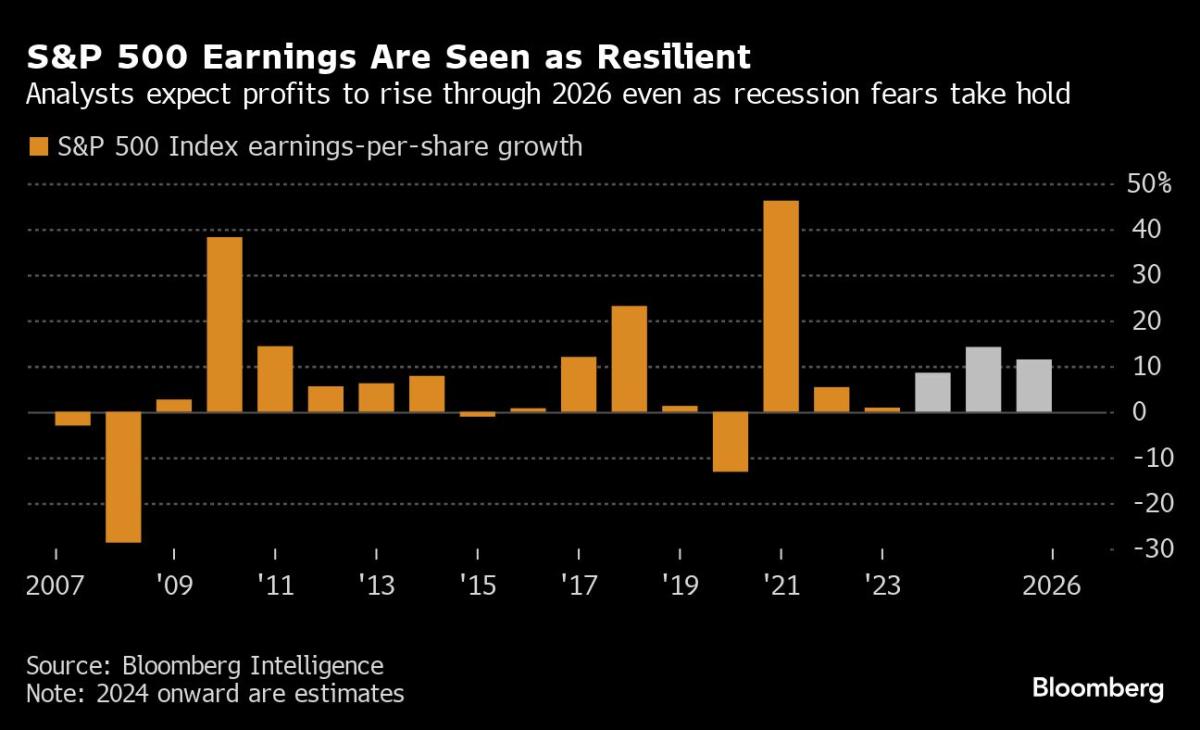
(Bloomberg) — Stocks climbed at the end of a dizzying week, with the market wiping out all the losses from a Monday selloff that rattled trading around the globe.
Most Read from Bloomberg
The S&P 500 halted what would be its longest stretch of weekly losses this year.
There’s been no shortage of drama in August, arriving at a time when the market was already showing signs of exhaustion after a torrid rally. Worries about the Federal Reserve being behind the curve after a couple of weak economic data points left traders on edge. The selloff got turbocharged after a rate hike by the Bank of Japan set off a surge in volatility in yen and hit carry-trade investors.
“Even if that nerve-racking event is over, we learned how sensitive markets now are to cooler US economic data, how broad-reaching the impact of the yen carry trade can be, and how conditioned investors are to expect rate cuts as the salve for every scrape,” said Liz Young Thomas at SoFi.
After pricing aggressive rate cuts this week, traders pared bets to about 100 basis points of Fed easing for the year. A large majority of economists surveyed by Bloomberg see only a quarter-point decrease coming in September — a finding that’s at odds with calls from some large Wall Street banks for a jumbo cut at the next meeting.
The S&P 500 rose 0.7%. Expedia Group Inc. climbed on better-than-expected results. Cisco Systems Inc. plans to eliminate thousands more jobs in a second round of layoffs this year, Reuters reported. Treasury 10-year yields fell six basis points to 3.93%.
Wall Street’s “fear gauge” — the VIX — subsided further on Friday, hovering around 20. That’s after an unprecedented spike that took the gauge above 65 on Monday, a rare level normally signaling utter panic. That unusual surge has raised some questions on whether the index was actually “overstating” all that stress in the US stock market.
The old saying that “volatility is the price you pay for equity market returns” is absolutely true, but deciphering what volatile markets say about the future is a valuable exercise nonetheless, according to Nicholas Colas at DataTrek Research.
“Current market conditions are not comfortable, to say the least,” Colas said. “But they are neither flashing a robust recession warning nor condemning the current bull market to a premature end. After a rough week, we take comfort in that message.”
Former Treasury Secretary Lawrence Summers urged the Securities and Exchange Commission and relevant exchanges to look into the historic surge in the most-watched gauge of US financial volatility on Monday.
“My understanding is that because there are some illiquid instruments that go into the calculation of the VIX, the VIX had a somewhat artificial move on Monday,” Summers said on Bloomberg Television’s Wall Street Week with David Westin on Friday. “Since that is so widely watched an indicator, issues of liquidity, issues around how it settles, I think should be studied by the relevant parties in the industry and the regulator — the SEC.”
As broad-based selling gripped equity markets early this week, a sentiment signal sank to one of its lowest points in history. T
he stock-bond ratio — which compares the S&P 500 against a long-dated Treasury to test whether equities are cheap or expensive compared to bonds — also serves as a measure for market sentiment, said Dean Christians at SentimenTrader.
And similar periods of panic-driven fear in the past were followed by excellent returns. Since 1962, the ratio dipped this far only 13 other times, and in more than 90% of those instances, the S&P 500 rallied a year later.
At Bank of America Corp., Michael Hartnett says the turbulence has yet to reach proportions that would signal worries about a hard economic landing.
“Technical levels that would flip Wall Street’s narrative from soft to hard landing have not been broken,” Hartnett said. “Investor feedback is ‘frazzled’,” but expectations of Fed rate cuts mean that preference for stocks over bonds hasn’t been ended by the market rout, he added.
For now, the absence of any major economic news until next Wednesday’s CPI release will likely lead to subsiding market volatility for now, according to Mark Luschini at Janney Montgomery Scott.
Still, he notes that August and September are seasonally weak for equities — so volatility might expect to be present, especially in the midst of a contested presidential election.
Some of the main moves in markets:
Stocks
-
The S&P 500 rose 0.5% as of 1:16 p.m. New York time
-
The Nasdaq 100 rose 0.5%
-
The Dow Jones Industrial Average rose 0.3%
-
The MSCI World Index rose 0.6%
Currencies
-
The Bloomberg Dollar Spot Index fell 0.2%
-
The euro was little changed at $1.0917
-
The British pound was little changed at $1.2758
-
The Japanese yen rose 0.3% to 146.75 per dollar
Cryptocurrencies
-
Bitcoin rose 1.8% to $60,632.94
-
Ether rose 1.4% to $2,606.46
Bonds
-
The yield on 10-year Treasuries declined four basis points to 3.95%
-
Germany’s 10-year yield declined four basis points to 2.22%
-
Britain’s 10-year yield declined three basis points to 3.94%
Commodities
-
West Texas Intermediate crude rose 0.8% to $76.81 a barrel
-
Spot gold rose 0.3% to $2,434.49 an ounce
This story was produced with the assistance of Bloomberg Automation.
–With assistance from Robert Brand, Chiranjivi Chakraborty and Richard Henderson.
Most Read from Bloomberg Businessweek
©2024 Bloomberg L.P.
EMEA Tribune is not involved in this news article, it is taken from our partners and or from the News Agencies. Copyright and Credit go to the News Agencies, email news@emeatribune.com Follow our WhatsApp verified Channel





